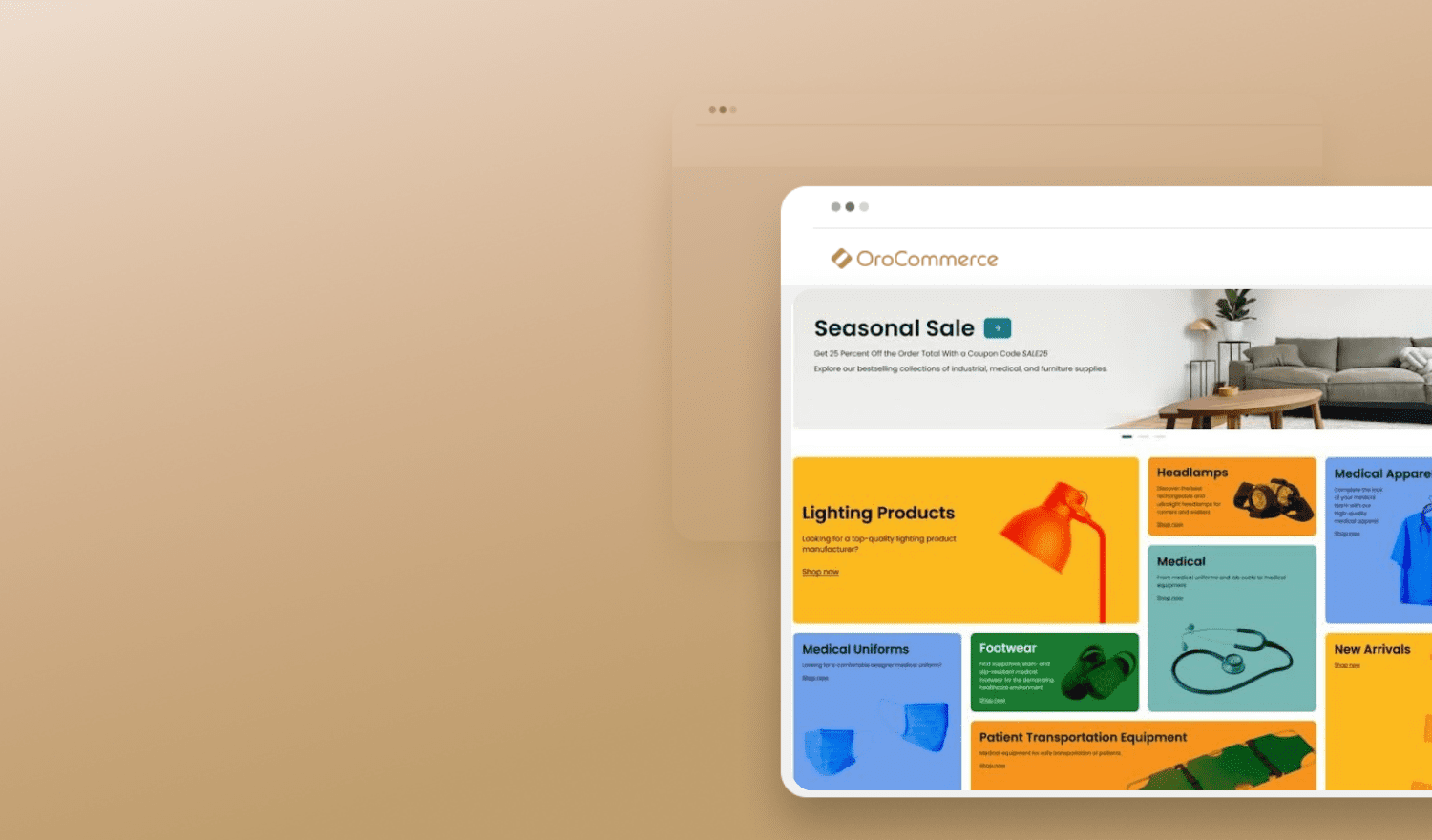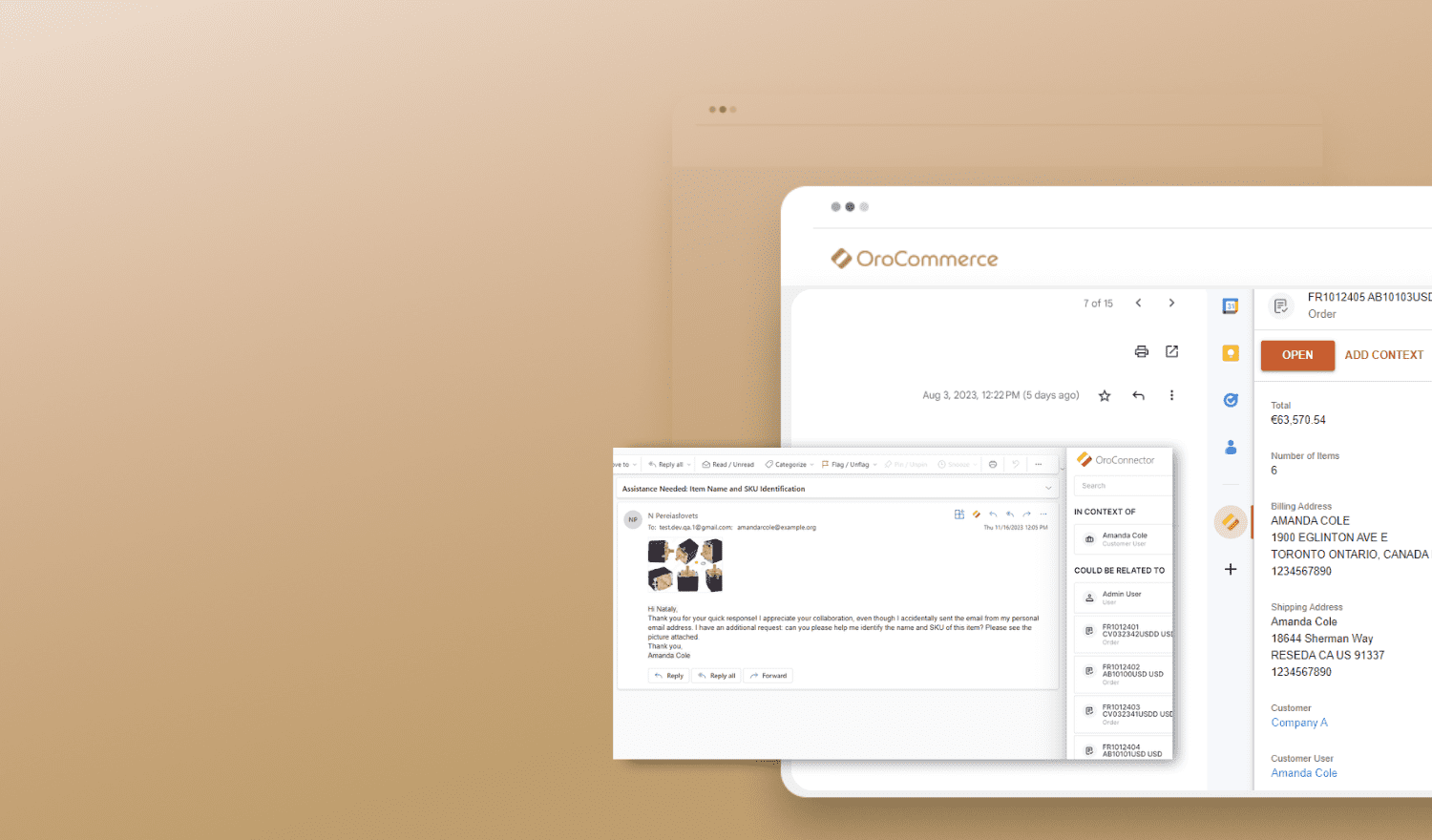navigation

When it comes to digital commerce architecture, there is no shortage of buzzwords these days. Just as Big Data was the big buzzword in the last half of the last decade, today designers and developers are talking about monoliths, composable software, headless architecture, and microservices when they discuss eCommerce architecture.
What does it all mean? And most importantly, what is the best architecture for your eCommerce site? Read on to discover the meaning behind these buzzwords, learn eCommerce site architecture best practices, and how to determine which approach will provide the results you need. Once you get past the buzzwords, you’ll see these are mostly new ways to frame existing approaches to eCommerce architecture.
Consider eCommerce Project Architecture When Planning
Exactly what is eCommerce architecture anyway? To understand project architecture, it helps to compare your eCommerce application to a new construction project.
You wouldn’t build a house or office building without a set of blueprints. Without a blueprint, the craftsmen don’t understand how the mechanical systems come together, what provides structural support, and how the finished building will look. They rely on the architect to create blueprints that include how the finished building looks as well as how it is put together.
Building a well-functioning B2B eCommerce store is no different. Instead of wood, bricks, and cement, you must bring together software, logic, and workflows to create customer experiences to delight website visitors. Just like bricklayers and plumbers coming together to construct a building, your eCommerce architecture makes up of different functional layers necessary to bring your eCommerce project to life.
Each eCommerce project is different. So the architecture that works for one company might not be the best for your company. You need to look at your options and consider the goals you set for your eCommerce endeavor.
Meeting rising customer expectations
Modern B2B buyers say they want an Amazon-like experience. In other words, they want to find the information they need to make a decision about your products and they want to make a purchase. Gen Z and Millennial buyers depend on the internet to do their product research.
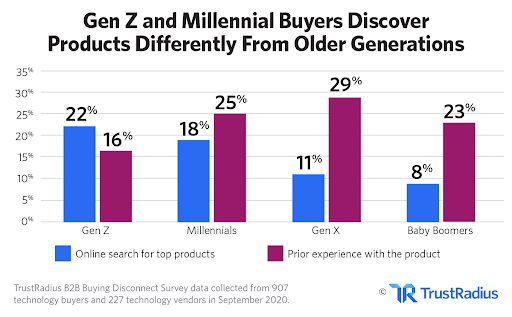
It’s important that when buyers land on your website, they get the customer experience they want. The best architecture for your eCommerce site is the one that allows you to continually adapt to meet the demands of ever-rising customer expectations.
Standing out from the competition
Your web presence is your opportunity to differentiate your brand from the competition. Building in accessibility and convenience such as live chat or AI-enabled chatbots helps you stay connected with customers long after the other guys have gone to bed. But these integrations require careful planning and are a great example of why your architecture must be considered in the planning stages.
Building a scalable and future proof solution
The project you complete this year should be the basis of the solution you will use in the years to come. Your architecture should enable scaling and innovating so your eCommerce ecosystem grows with you as it helps you continue to grow your business.
Streamlining development and implementation
When considering your eCommerce website architecture design, it’s important to know your goals for getting to market. Some approaches require more development and implementation work than others and can slow down the time to market.
Creating a visual roadmap
By considering your eCommerce website architecture design in the planning phase, you start with a tool that team members can use to visualize site functionality and necessary integrations. As you work through the project, you’ll find that you refer to this road map often along the way.
How to Build a Reliable and Secure OroCommerce Infrastructure
Factors to Consider When Choosing eCommerce Architecture
How you approach your eCommerce portal architecture will impact your entire project. From defining the elements of your eCommerce storefront to determining where data will reside and how it will flow, your choice of architecture is key. So, before you consider the available options it is important to take stock of your company, your resources, and your project goals.
Start with strategic assessment
Digital Maturity. Assess your digital maturing or how well your company can presently add value through technology. Is this your first eCommerce website? What technology do you currently use for marketing, sales, and order processing?
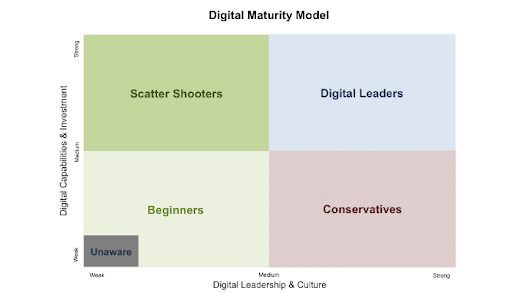
[Source]
The architecture used by a company that has low digital leadership and low capabilities will be different from a company that has already made a large commitment to technology and is well on its path to digital transformation.
Software Needs. What software will you need for your project? Will your eCommerce store be supported by PIM, CRM, or CMS? Is this new technology or technology that is changing along with the eCommerce application?
Existing Ecosystem. What technology are you currently using? How will your eCommerce website integrate with your existing technology?
Technical Expertise. What human resources do you have and what extra resources will you need to develop and implement your project. Will you outsource some activities and keep some in-house?
Support Requirements. Once implemented, what type of support will you need? Do you anticipate that current staff is sufficient to support your project or will you need vendor and community support?
Define Customer Experience Goals. You should have a handle on the experience you want to create for your customers. The richer and more robust the experience, the more likely the system architecture of your eCommerce website will be complex.
Resources and data
Now that you’ve established where you are and where you want to go, you can begin to flesh out the best eCommerce architecture to get you there.
Gather Resources. Identify your internal and external human resources, including project consultants. Don’t overlook the power of digital transformation consultants and eCommerce consultants to guide you on the path to success.
Analyze and Map Data. Identify where your data is currently located.
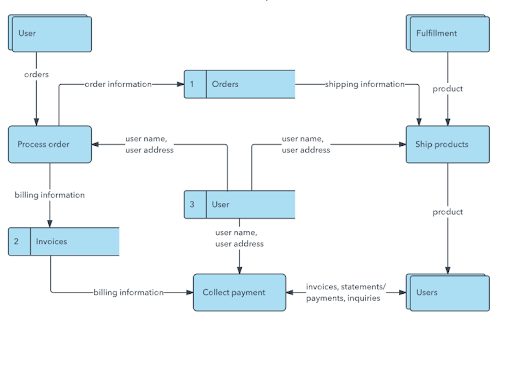
[Source]
Show not only where your data is located, but how data flows through your current system. This process picks up any integrations you might have missed earlier and provides a visual reference for simplifying data flow if that is one of your project goals.
MVP goals
It is important to understand the goals of your minimum viable project (MVP). The eCommerce MVP approach to creating your webstore will help you validate the value added by eCommerce, test integrations, and reduce the commitment of time and money for the project while getting you to market faster.
Reduce risk and save costs with an MVP approach.
The MVP approach will also ensure that iterations to continually improve your customer experience and backend efficiency take place. It also ensures that the architecture you choose in the beginning will support your plans for future growth.
Comparing eCommerce Architecture Options
Now that we’ve looked at the importance of strategy and the factors affecting the architecture decision, let’s dive into the actual architecture options. Reader warning – buzzwords ahead!
Monolithic architecture
Monolithic architecture is the traditional model used by most software programs. These solutions are generally large and self-contained. The platform may have many modules, but the modules are all interconnected. A change in one module usually necessitates a change in other areas and may require you to redeploy the entire solution.
In the case of eCommerce platforms, the monolith gets a request through HTTP and then takes action by executing business logic; accessing a database; exchanging messages with other systems; and returning a response.
The monolithic system architecture of an eCommerce website looks like this:
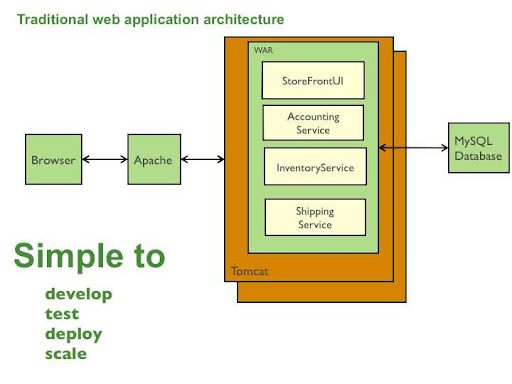
An example of an architecture diagram for an eCommerce website [Source]
On the plus side, development and deployment are fairly simple. On the downside, this simplicity doesn’t give you much control over how you develop or deploy. It does scale easily by placing multiple copies of the code behind a load balancer. But while it scales to handle more transactions, scaling to handle more data is much trickier.
As you make changes to the modules, the code becomes increasingly complex. Because the modules are interconnected, a change in one module requires the redeployment of the entire application.
What you give up in flexibility and adaptability, you can in time to market. It may not be exactly what the company needs or wants, but it can be pushed out quickly.
When breaking down this buzzword, just think of your traditional software package like Microsoft Office Suite.
Modular architecture
Modular eCommerce architecture is based on the idea that it is better to break monolith modules down into actual modules that are loosely connected.
Each module has a task or service it performs and it works within its own container to do its job. Each module connects with other modules to transfer data. Because the individual modules are separate, you can make changes to one module without deploying the entire application again.
The modules depend on a well-defined and stable API to work together. Buzzword alert! Because each module performs a separate task or service, modules are referred to as microservices.
Here is what an eCommerce architecture design looks like when you take a modular approach with microservices.
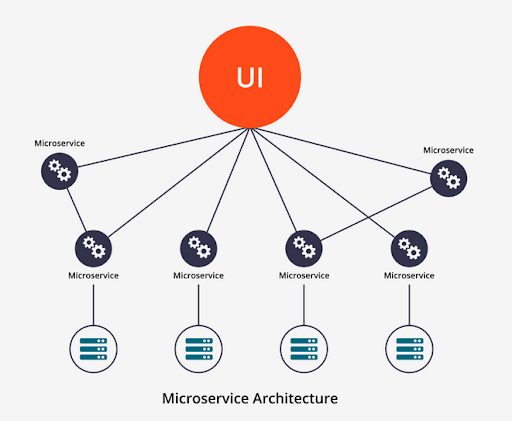
[Source]
There are great practical benefits to taking this modular approach to eCommerce architecture. Teams can work independently of each other and bugs and problems are solved within the module before it is connected.
If you’ve heard the buzzword, API-first approach, this term refers to creating an eCommerce (or other solution) product that can be considered a microservice and is ready to be connected to other microservices.
This approach gives you powerful flexibility in development and deployment. On the downside, with that great power comes complexity. This architecture can be intricate.
Composable architecture
No discussion of eCommerce architecture design and associated buzzwords is complete without addressing composable architecture.
To understand composable eCommerce, you first must understand the software as a service (SaaS) model. With SaaS solutions, you use the vendor’s product as a cloud-based service. The software doesn’t reside on your own servers and you access it through the internet.
Composable architecture uses APIs to connect various SaaS products. Basically, you are building a network of modular microservices. The modules don’t need to come from the same vendor. And events trigger the interactions. It looks a bit like this:
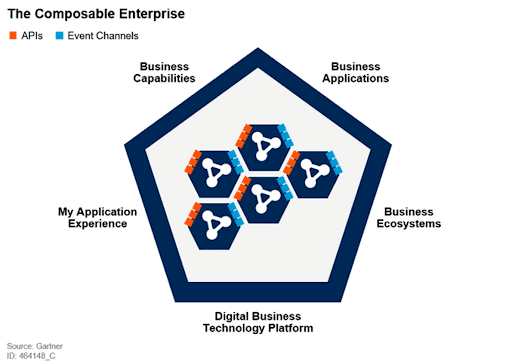
Composable allows you to pick the bits and pieces you want to cobble together your own solution. Your CMS, eCommerce shopping cart, CRM, and marketing and eCommerce automation can be provided by different SaaS providers.
If you’ve ever heard the buzzword headless architecture it references decoupling the frontend of your website from the backend.
Composable architecture can get you to market fast because teams are focused on how the parts go together. That’s a great benefit. But there is also an equally big downside, and that is security. With data moving between so many parts, the opportunities for a breach increase. Your ecosystem security is only as strong as the weakest link.
The Oro Approach to eCommerce Architecture: Flexible eCommerce
OroCommerce eschews buzzwords and takes an approach that gets B2B brands to market with rich customer experiences on the front end and a powerful backend for improving workflows, automating processes, and improving efficiency. We call it Flexible eCommerce architecture. It’s not a buzzword, it is a proven way to create an architecture that is as unique as the way you do business. Technology conforms to the company, not the other way around.
Flexible control through flexible eCommerce
With Flexible eCommerce, the experience you want to create is the driver. You have the amount of control you want to create the experiences that your customers demand. Most of the B2B functionality you need comes right out of the box. And if the functionality isn’t structured the way you want, you can change it. The workflow engine allows you to automate processes and structure the workflow to fit your processes.
How do top midmarket brands use technology?
Forrester shares real-life case studies from leading business sellers.
OroCommerce fits your architecture strategy
No matter your architecture strategy or your buzzwords, OroCommerce adapts to your business case. Whether you take a traditional monolithic approach or are looking at modular microservices or a headless architecture, OroCommerce fits your strategy.
OroCommerce as a monolith
Analysts rate OroCommerce as the best B2B eCommerce platform because it’s designed from the ground up to handle B2B transactions. You can deploy OroCommerce on your own servers or in the OroCloud. As a traditional eCommerce platform, you’ll find all the features you need for selling, marketing, and connecting your eCommerce store to your other business systems. And when it is time to expand, OroCommerce will grow with you.

When the demand for PPE skyrocketed due to COVID-19, Midway Dental was able to quickly stand up a separate website dedicated to these products and manage it from their existing backend. Instead of weeks to market, they took mere days.
That’s the power of OroCommerce as a monolith. Read the entire case study.
OroCommerce as modular
OroCommerce’s Flexible eCommerce nature means it works well with modular architecture too. You can pick the functionality that works for your business (such as native support for B2B selling models) and add on other solutions to create the system that works for your company. Want to use another CMS? That is not a problem with OroCommerce. Prefer to manage product information with an existing PIM? OroCommerce can do that too.

OroCommerce provided the foundation for the eCommerce experience. Salsify manages pricing, product category information, product content, and digital assets while Cybersource performs gateway functions, Avalara manages taxes, and FedEx and other LTL services handle shipping. MountainTarp takes the best services from multiple vendors and brings them together. They experienced an 8-fold increase in traffic with their modular architecture. Read the complete success story.
OroCommerce headless or composable
OroCommerce fits with a composable or headless strategy as well. Because of its extensive API, you can use OroCommerce as an order management system or middleware to connect ERPs.

Initially, they needed a way to connect their existing systems into a more unified architecture. OroCommerce’s strong backend supported order management and brought together their many ERPs. As they added new selling channels, they simply connected them to OroCommerce. Now OroCommerce manages information from multiple catalogs in a single platform. Customers get custom catalogs and price lists and workflows are smoother for everyone. Read the case study.
In Conclusion: Match Architecture to Goals
So now you know the different architecture concepts, don’t let those buzzwords be a stumbling block.
Picking the best architecture for your eCommerce website is all about matching your goals and strategy to the technology level that meets your maturity level. If your B2B eCommerce website is just the first step in your digital transformation, remember that getting started is more important than getting it perfect, and you should always leave the door open to continued improvement.
If your digital maturity is low, a monolithic architecture gets you going. Select wisely so you get the flexibility you need to scale and offer continually improving customer experiences.
If your organization is more digitally mature and you already have systems that work well together, a modular or composable architecture may best fit your needs. The most flexible solutions operate on the full continuum from monolith to microservices and everything in between.
Let us help you make sense of your eCommerce architecture
We can build a strong foundation for your eCommerce success.
Questions and Answers
What is eCommerce architecture?
The term eCommerce architecture refers to how data and business logic interact to create a website with ordering capabilities. It’s how the information that’s required to operate a website comes together.
Which architecture is used for eCommerce sites?
Most architecture runs with the user interface on the client-side and the business logic and data storage on the server-side. But there are many variations in eCommerce. Monolithic eCommerce architecture utilizes a single, large self-contained software solution and modular architecture breaks each service down into a separate module. All the modules work together but you can change one module without deploying the entire solution again.
Which architecture is best for eCommerce?
The best architecture for eCommerce fits the strategy, goals, and digital maturity of the company. It enables the brand to create the customer experience their buyers demand while also meeting business goals for growth and stability.
What is web-based eCommerce architecture?
Web-based eCommerce architecture depends on products created by cloud-based SaaS vendors. The modules are connected with APIs.
What are the fundamental architectural elements of eCommerce?
The presentation layer is the user interface or the portion of the website your customers see. The business layer is where business logic takes place. Many of the data processing requests (such as customer requesting order history) happen at this layer. The data layer is where final data requests are processed. This layer can be connected to the database or simply send data to data services for handling.
Why does site architecture play an essential role in an eCommerce strategy?
The architecture you choose can limit your eCommerce strategy. For example, a monolithic solution may not provide the connectivity and flexibility you need to reach your goals. On the other hand, a complex set of microservices may be beyond the digital maturity of your company.


